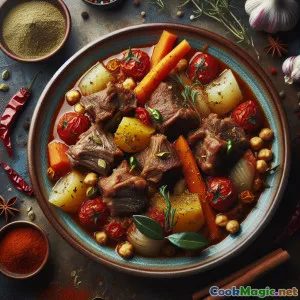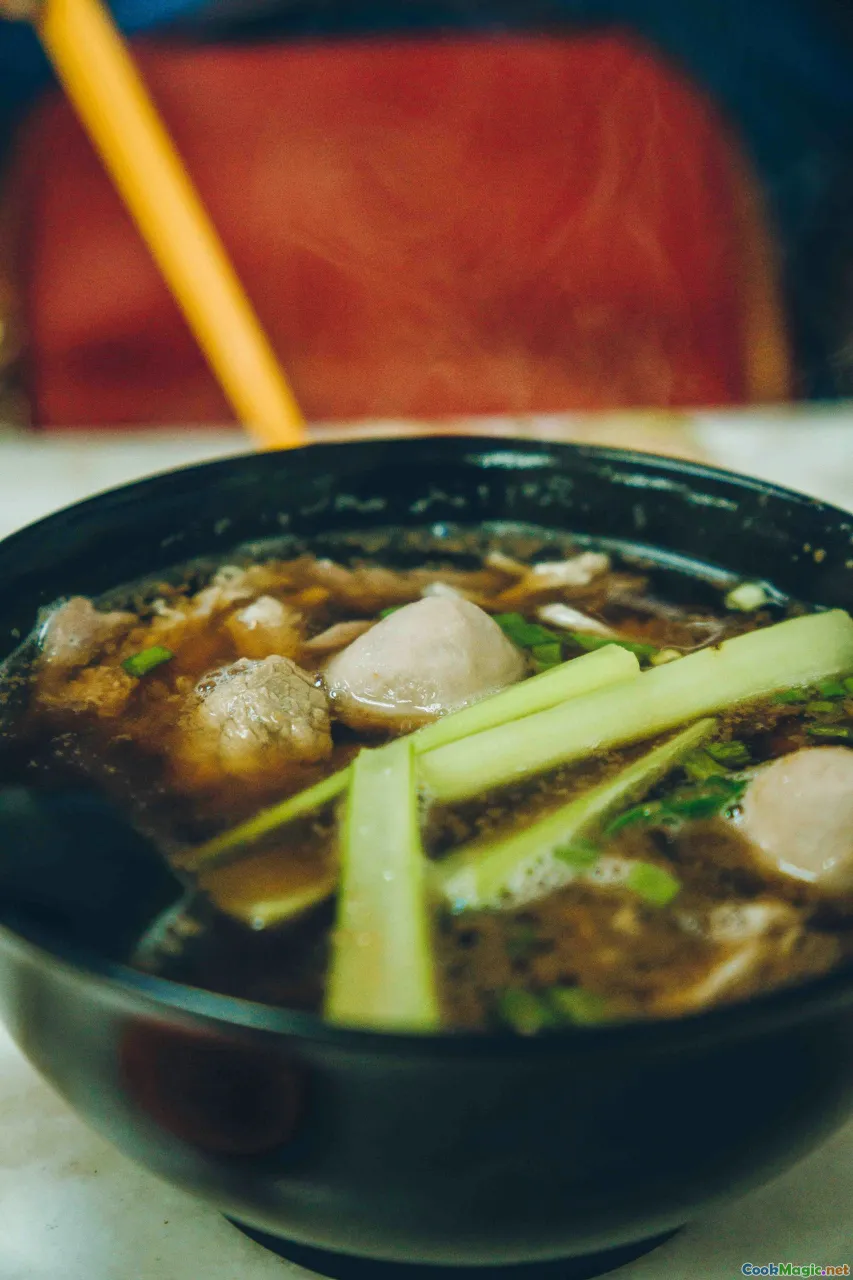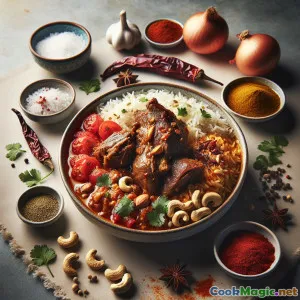
Semur kambing Bedouin dengan Loomi dan rempah-rempah
(Bedouin Lamb Stew with Loomi and Spices)
(0 Ulasan)0
337
November 06, 2025
Laporkan Masalah
Bahan
-
1200 grams Bahu kambing dengan tulang, dipotong menjadi kubus 4 cm
(Marbled cuts yield best flavor and tenderness)
-
3 tbsp Ghee
(Or use clarified butter)
-
2 large Bawang bombay kuning, diiris tipis
(Adds body and natural sweetness)
-
6 cloves Siung bawang putih, dihancurkan
(Crush to release oils)
-
3 medium Tomat matang, dicincang
(Canned diced tomatoes work in a pinch)
-
2 tbsp Pasta tomat
(Concentrates umami and color)
-
3 pieces jeruk nipis hitam kering (loomi)
(Pierce each 3–4 times to release citrusy aroma)
-
2 pieces Daun salam
(Earthy, subtle backbone)
-
1 stick Batang kayu manis
(Warm, woody depth)
-
6 pods Buah kapulaga hijau, dihancurkan ringan
(Bruise to expose seeds)
-
1 tsp Kunyit bubuk
(Color and gentle bitterness)
-
2 tsp Jinten bubuk
(Savory base note)
-
1.5 tsp Ketumbar Bubuk
(Citrusy lift)
-
1 tsp Baharat (campuran tujuh rempah Arab)
(Optional but traditional; deepens aroma)
-
2 medium Wortel dipotong menjadi batang tebal
(Menambah manis dan warna)
-
2 medium Kentang waxy, dikupas dan dipotong dadu
(Holds shape in long simmer)
-
1 cup Kacang arab rebus, tiriskan
(Optional for extra body and protein)
-
0.5 tsp Cabe merah kering atau serpihan cabai
(Heat to taste)
-
1200 ml Air atau kaldu domba
(Enough to barely cover meat)
-
1.5 tsp garam laut halus
(Sesuaikan dengan selera)
-
1 tsp Lada hitam baru giling
(Sesuaikan dengan selera)
-
2 tbsp Daun ketumbar segar, dicincang
(Hiasan)
-
1 tbsp Jus Lemon Segar
(Optional bright finish if loomi is mild)
(Marbled cuts yield best flavor and tenderness)
(Or use clarified butter)
(Adds body and natural sweetness)
(Crush to release oils)
(Canned diced tomatoes work in a pinch)
(Concentrates umami and color)
(Pierce each 3–4 times to release citrusy aroma)
(Earthy, subtle backbone)
(Warm, woody depth)
(Bruise to expose seeds)
(Color and gentle bitterness)
(Savory base note)
(Citrusy lift)
(Optional but traditional; deepens aroma)
(Menambah manis dan warna)
(Holds shape in long simmer)
(Optional for extra body and protein)
(Heat to taste)
(Enough to barely cover meat)
(Sesuaikan dengan selera)
(Sesuaikan dengan selera)
(Hiasan)
(Optional bright finish if loomi is mild)
Nutrisi
- Porsi: 6
- Ukuran Porsi: 1 mangkuk (350g)
- Calories: 480 kcal
- Carbohydrates: 0 g
- Protein: 34 g
- Fat: 28 g
- Fiber: 4 g
- Sugar: 6 g
- Sodium: 780 mg
- Cholesterol: 110 mg
- Calcium: 85 mg
- Iron: 4.7 mg
Instruksi
-
1 - Bloom the Spices:
In a heavy pot over medium heat, warm the ghee. Add cinnamon, cardamom, cumin, coriander, turmeric, and bay leaves. Stir until fragrant, about 60–90 seconds, without burning.
-
2 - Brown the Lamb:
Increase heat to medium-high. Add lamb in batches, seasoning lightly with salt and pepper. Brown well on all sides to build fond. Transfer browned pieces to a plate.
-
3 - Soften Aromatics:
Lower heat to medium. Add onions and a pinch of salt. Cook, scraping up browned bits, until golden and soft, 6–8 minutes. Stir in crushed garlic for 30–45 seconds.
-
4 - Tomato base:
Add tomato paste; cook until it darkens and smells sweet, 1–2 minutes. Stir in chopped tomatoes and cook down until jammy and reduced by about one third.
-
5 - Introduce the loomi and liquid:
Prick each loomi 3–4 times with a skewer. Return lamb and juices to the pot. Add loomi and pour in water/stock to barely cover. Bring to a gentle simmer, cover, and cook 60–70 minutes until lamb is tender.
-
6 - Add vegetables and chickpeas:
Stir in carrots, potatoes, chickpeas, and optional chili. Simmer uncovered until vegetables are tender and the stew thickens slightly, 12–15 minutes.
-
7 - Season and balance:
Taste and adjust salt and pepper. If the loomi’s citrus note is subtle, finish with lemon juice for brightness. Remove cinnamon stick, bay leaves, and loomi.
-
8 - Rest and Garnish:
Let the stew rest off heat for 2–3 minutes to settle flavors. Sprinkle with chopped cilantro just before serving.
-
9 - Serve:
Serve in warm bowls with flatbread or over steamed rice, bulgur, or pearl couscous to soak up the aromatic gravy.
In a heavy pot over medium heat, warm the ghee. Add cinnamon, cardamom, cumin, coriander, turmeric, and bay leaves. Stir until fragrant, about 60–90 seconds, without burning.
Increase heat to medium-high. Add lamb in batches, seasoning lightly with salt and pepper. Brown well on all sides to build fond. Transfer browned pieces to a plate.
Lower heat to medium. Add onions and a pinch of salt. Cook, scraping up browned bits, until golden and soft, 6–8 minutes. Stir in crushed garlic for 30–45 seconds.
Add tomato paste; cook until it darkens and smells sweet, 1–2 minutes. Stir in chopped tomatoes and cook down until jammy and reduced by about one third.
Prick each loomi 3–4 times with a skewer. Return lamb and juices to the pot. Add loomi and pour in water/stock to barely cover. Bring to a gentle simmer, cover, and cook 60–70 minutes until lamb is tender.
Stir in carrots, potatoes, chickpeas, and optional chili. Simmer uncovered until vegetables are tender and the stew thickens slightly, 12–15 minutes.
Taste and adjust salt and pepper. If the loomi’s citrus note is subtle, finish with lemon juice for brightness. Remove cinnamon stick, bay leaves, and loomi.
Let the stew rest off heat for 2–3 minutes to settle flavors. Sprinkle with chopped cilantro just before serving.
Serve in warm bowls with flatbread or over steamed rice, bulgur, or pearl couscous to soak up the aromatic gravy.
Informasi Lebih Lanjut: Semur kambing Bedouin dengan Loomi dan rempah-rempah
Bedouin Lamb Stew with Loomi: A Desert-Born Classic
Bedouin Lamb Stew with Loomi is a bowl of desert wisdom—simple ingredients, patient technique, and a flavor profile that feels both ancient and startlingly modern. The soul of this stew is loomi, the dried black lime beloved across the Arabian Peninsula. Its role is transformative: it infuses the broth with delicate citrus, a gentle tannic edge, and a ghost of smoke that pairs effortlessly with lamb’s richness.
What Is Loomi?
Loomi, also known as dried Persian or Omani lime, is made by boiling fresh limes in brine and sun-drying them until their skins darken and the pulp turns tangy and tea-like. In Bedouin cooking, where fresh produce historically traveled poorly, loomi offered preserved acidity without spoilage. Unlike the sharp hit of fresh lemon, loomi’s flavor is round and integrated—a citrus that has learned patience. When pierced and simmered, it slowly perfumes the stew rather than dominating it.
Technique: Building Flavor in a Sparse Landscape
This stew relies on layering. First, spices bloom in ghee, unlocking fat-soluble aromatics. Browning the lamb then builds a fond—the caramelized base that deepens color and taste. Onions and garlic are softened in the same pot to gather every last molecule of flavor. Tomato paste darkens to develop umami, while fresh tomatoes reduce into a jammy base.
Only then do the loomi and liquid enter, and this is where restraint shines. Add just enough water or stock to barely cover the meat; a Bedouin pot traveled over embers, not a roaring fire, and economy was key. A gentle simmer coaxes collagen into silky gelatin. The final stage adds vegetables, giving the stew a natural body without relying on flour—ideal for gluten-free diners.
Ingredient Insights and Substitutions
- Lamb shoulder is the gold standard for tenderness and flavor. If you must substitute, beef chuck works, but you’ll lose some of the lamb’s luxurious aroma.
- Ghee offers nutty depth and high-heat stability. Olive oil can stand in, but the aroma will shift.
- Baharat is optional but delightful. A teaspoon of a good blend adds warmth without heat.
- If you don’t have loomi, slice a lemon into quarters and dry it on low heat in the oven until leathery, then simmer. It’s not identical, but surprisingly close.
- Chickpeas add protein and body. If using, reduce potato slightly to keep the stew from turning too starchy.
Tips for Success
- Pierce the loomi several times to help the stew access its inner oils. Drop them in whole; they are removed before serving.
- Simmer gently. A hard boil can toughen meat and muddy the broth.
- Salt in stages. Initial seasoning helps browning and vegetable sweetness; final seasoning ensures the balance of saline, spice, and citrus.
- Rest the stew for a few minutes before serving. Flavors knit together and the surface fat settles, making it easier to skim if desired.
- Next-day magic: Like many stews, this tastes even better after a night in the fridge, as loomi fully penetrates the meat.
Serving and Pairings
Traditionally, this would be shared from a communal pot, with flatbreads serving as spoon and plate. Today, it’s gorgeous with steamed rice, bulgur, or pearl couscous. A crunchy side salad—tomato, cucumber, red onion, mint—refreshes the palate between bites. For a complete Arabian-inspired spread, offer pickled turnips and a bowl of plain yogurt to cool the spices.
Cultural Significance
This dish speaks to Bedouin life: bounded by scarcity, expanded by ingenuity. In a world of sand and sky, preservation was survival. Spices traveled well; so did dried limes. Lamb—raised on the move—offered both feasts and sustenance. Stewing over low heat mirrors the rhythms of travel and rest, the slow patience of a campfire night. Each loomi is like a memory of the sun, stored and released only when the pot needs it.
Unique Aspects
- The aromatic trifecta of loomi, cinnamon, and cardamom creates a flavor silhouette distinct from Levantine lemon stews or Moroccan preserved lemon tagines.
- The stew is naturally gluten-free and adaptable: swap potatoes for chickpeas, adjust heat with chili, or enrich with a knob of ghee at the end for shine.
- It’s a one-pot dish that handles both casual family dinners and ceremonial spreads, scaling up effortlessly for gatherings.
Make-Ahead, Storage, and Reheating
- Make ahead: Cook through and cool completely. Refrigerate up to 4 days or freeze up to 3 months.
- Reheat: Gently on the stovetop with a splash of water or stock. Remove the loomi before storage to prevent over-extraction and bitterness.
- Leftovers: Shred leftover lamb and fold into flatbread with a spoonful of stew, fresh herbs, and yogurt.
Final Thoughts
Bedouin Lamb Stew with Loomi is cuisine as storytelling—resourceful, generous, and deeply human. With every simmering minute, it invites you to slow down and savor: the tang of the desert sun captured in loomi, the tenderness coaxed from humble cuts, the warmth of spice that feels like company on a long road. It is a recipe to return to, a pot that rewards patience and fills a table with stories.





















